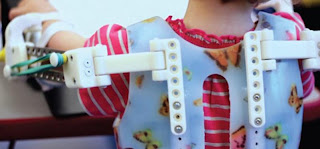All the things you like about ULTEM, but in black!
ULTEM 9085 from SABIC Innovative Plastics has superior strength, is light weight, and has other desirable characteristics, including FST rating. The FST (flame, smoke and toxicity) rating is a safety standard that ensures a material won't promote a fire, release harmful smoke, or emit toxic fumes, and it is particularly valued in the transportation industries.
"The majority of our tan ULTEM users have requested the material also be available in black, because it gives a uniform look to product assemblies," said Fred Fischer, business development director at Stratasys. "It also helps mask dirt or grease found in mechanical systems or under the hood, in the fuselage, or on the manufacturing floor. For many users, the black color will eliminate the need for non-value-added post-processing step of painting or coating."
Truck fender and accessory manufacturer, Minimizer, uses ULTEM when creating both fender and mounting component prototypes. Mounting brackets are commonly made from glass fiber and tough, rigid plastics, which can be a challenge to prototype, according to Minimizer mechanical engineer, Martin Larsen.
"When we make an FDM part and mount it on a truck there's a lot of drilling, using fasteners and even mating parts together," he says. "We found that (because) the ULTEM has high tensile strength and is rigid, it's a good alternative for us to prototype with. Having the black material is a big bonus for us. We don't have to spend the time to finish the part, and we get the same material properties we look for in the (standard) ULTEM material."
Like standard ULTEM 9085, the black color material has a V-0 flammability rating. The material is heat resistant up to 320° F (160° C) and is inherently flame-retardant, offering full FST compliance including OSU heat release of less than 55/55, or 55 kw min/m2 for heat release and 55 kw/m2 for peak heat release.
The material's impact strength also makes it appealing to the aerospace industry, where high-strength, lightweight parts are extremely valuable.
In addition to the automotive and aerospace industries, Stratasys anticipates that black ULTEM 9085 will be useful for construction, agriculture and industrial equipment manufacturers.
Tan and Black ULTEM 9085 are now available at RedEye Australasia.
Call 1300 559 454 or email enquiries@redeyerpm.com.au for more information or competitive quote on your next project.














